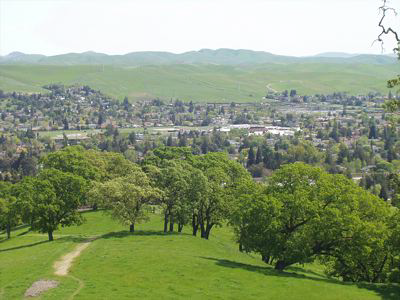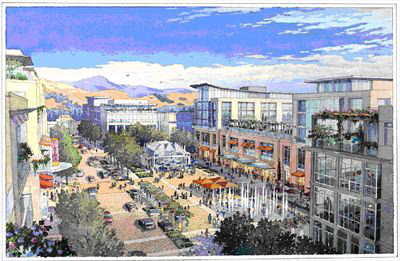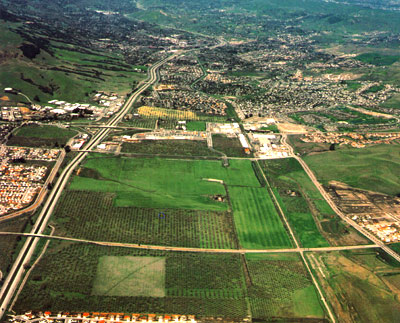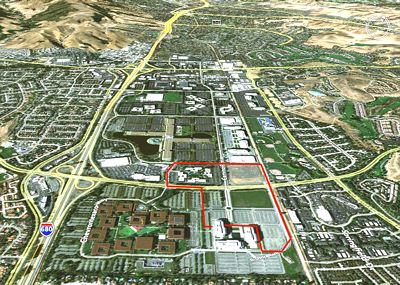No Light Rail in Vancouver!
Anti-

In our continuation of Anti-

Flickr photo of San Ramon by Jeff L. Used by permission.
The city is the world headquarters of Chevron-
But the city is suffering from an acute case of “downtown envy,” a disease the strikes many Sun Belt cities. Many people, including most urban planners, think that a city can’t be a real city unless it has a distinctive downtown or city center. But in today’s automobile age, developers no longer build distinctive city centers, so cities that have grown up since 1945 often feel they have to subsidize them.

Proposed San Ramon City Center
So Alex Mehran, of Sunset Development Company, has proposed to turn 17 acres owned by the city and 22 acres of his own into a City Center, a downtown, a central gathering place for San Ramon residents. Mehran, more than anyone else, made San Ramon what it is today: not just a bedroom suburb but a huge office campus.

In 1978, Mehran took 585 acres, much of which once formed part of the largest Bartlett pear orchard in America, and turned them into the Bishop Ranch office park. The above view shows this land in 1978; today, Chevron occupies the lower left corner, and Toyota, AT&T, and various office and retail complexes are scattered throughout the rest of what in 1978 were farm lands.

The above Google Earth image shows Bishop Ranch today. The area outlined in red is the proposed city center. In addition to the city’s 17 acres, Mehran is asking for some of the sales and property taxes that will be collected from the development to help finance the project. In exchange, he will build a city hall, library, a transit village, a new shopping mall, and a public plaza with an ice rink.
I lived in San Ramon one semester when I was teaching at Berkeley, and it is a nice place. Mehran’s vision in 1978 was that San Francisco was too expensive and too congested and so many companies would want to locate in a suburb that was relatively free of congestion. He provided them with just such a place. He was successful enough (and highly praised by Joel Garreau’s Edge City) that it is hard to be critical of his new vision.
Yet I have to wonder if San Ramon needs more density. Thanks to environmental demands that all available greenspaces be kept green, San Ramon’s population density has already increased to 4,400 per square mile, which is pretty high considering all the land that is in office parks. Mehran’s proposal will just add to the density, which will add to the congestion. Mehran himself lives in San Francisco, so he probably don’t mind density, but many San Ramon residents are not too keen on the idea.
I also have to wonder if Mehran has overestimated the role of “transit” in the proposed transit village. San Ramon is served by four bus lines that connect it to other cities in Contra Costa County and to BART stations in Dublin (7 miles away) and Walnut Creek (13 miles away). To use one of these buses, most residents have to drive to the Bishop Ranch Transit Center. I always rode my bike to the BART stations, so I don’t know how many use the buses, but considering that two of the bus lines go only every 40 minutes during rush hours and the other two are express buses that only operate four or five times a day, I doubt they are heavily used by San Ramon residents.
Finally, I have to wonder just how much tax money is involved and whether the city will get its money’s worth. The city’s reports on the plan are all very vague about how much tax money will go to Mehran’s company. Is Mehran expecting subsidies for his retail shops, offices, and dense housing? How will those subsidies affect other businesses? For example, the city already has an indoor ice rink in an area that the city wants to declare “blighted” so it can do some redevelopment. If Mehran’s plan puts the older rink out of business, the city might be able to convince people the area is blighted.
At the city council meeting that first heard Mehran’s proposal, someone testified
that San Ramon “needs a downtown.” Why? San Ramon is not a pedestrian-
Downtowns, as envisioned in the San Ramon City Center plan, are obsolete in many ways. I’ll look forward to seeing the financial analysis for this plan, but until it is clear that local taxes are only going for the city hall, library, and other public buildings, I will remain skeptical.
11
Trackback • Posted in City planning
Reprinted from The Antiplanner